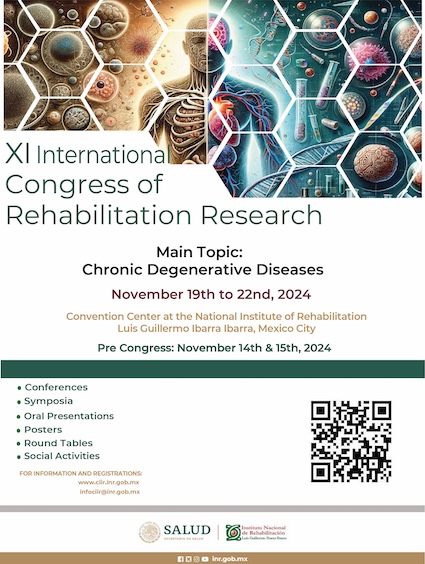Aprosodia. A case report
DOI:
https://doi.org/10.35366/116872Keywords:
aprosody, linguistic prosody, emotional prosody, stroke, right cerebral hemisphereAbstract
Introduction: prosody is the language component that includes the acoustic features that contextualize the message and provide meaning to discourse. There are two types: emotional and linguistic prosody. Aprosody refers to the deficit in the production and comprehension of these suprasegmental linguistic elements or prosodic cues. This condition is caused by damage to the right cerebral hemisphere, primarily due to a stroke or traumatic brain injury, resulting in cognitive and communicative impairments. Evaluation and diagnostic tests exist to detect typical communication difficulties in social interactions. Alterations in the expressive language quality affect interpersonal aspects of life, reducing participation, social engagement, interpersonal functioning, and quality of life for those who suffer from it. Therefore, treatment is tailored to the individual’s specific physiopathology. Objective: to present a clinical case of aprosody and the associated linguistic alterations. Case presentation: the case of a 56-year- old patient who experienced an ischemic vascular event in the right hemisphere is described. The «Western Aphasia Test» and the «Montreal Communication Evaluation Protocol» were administered, conducting a qualitative analysis of the patient’s disturbances in both expressive and receptive speech. Discussion: the initial evaluation of a patient with mixed aprosody is described, including
its classification and the deficits he presented in suprasegmental language aspects.
Conclusion:
aprosody is a complex pathology that requires a multidisciplinary approach and comprehensive assessment. Different assessment tools are available that need to be utilized to diagnose it, providing potential areas for improvement in the affected patient rehabilitative care.
References
Blake ML. The right hemisphere and disorders of cognition and communication: Theory and clinical practice: Plural Publishing, Incorporated. 2018.
Sheppard SM, Meier EL, Zezinka Durfee A, Walker A, Shea J, Hillis AE. Characterizing subtypes and neural correlates of receptive aprosodia in acute right hemisphere stroke. Cortex. 2021; 141: 36-54. doi: 10.1016/j.cortex.2021.04.003.
Peppé SJ. Why is prosody in speech-language pathology so difficult? International Journal of Speech- Language Pathology, 2009.11 (4), 258-271.
Pell MD. Cerebral mechanisms for understanding emotional prosody in speech. Brain Lang. 2006; 96 (2): 221-234.
Leon SA, Rodriguez AD, Rosenbek JC. 15 right hemisphere damage and prosody. The Oxford Handbook of Aphasia and Language Disorders, 2017. 277
NOTA:
Witteman J, van Ijzendoorn MH, van de Velde D, van Heuven VJ, Schiller NO. The nature of hemispheric specialization for linguistic and emotional prosodic perception: a meta-analysis of the lesion literature. Neuropsychologia. 2011; 49 (13): 3722-3738.
StockbridgeMD,SheppardSM,KeatorLM,MurrayLL, Lehman Blake M, Right Hemisphere Disorders working group, Evidence-Based Clinical Research Committee, Academy of Neurological Communication Disorders and Sciences. Aprosodia subsequent to right hemisphere brain damage: A systematic review and meta-analysis. J Int Neuropsychol Soc. 2022; 28: 709-735.
TompkinsCA,KlepousniotouE,GibbsSA.Natureand assessment of right hemisphere disorders. Aphasia and related neurogenic communication disorders, 2012. 297-332.
Joanette Y, Ska B, Coté H. ProtocoleMEC, ProtocoleMontréal d’évaluation de la communication. Ortho éd. 2004. ISBN: 978-2-914121-18-7.
Benedetti V, Weill-Chounlamountry A, Pradat-Diehl P, Villain M. Assessment tools and rehabilitation treatments for aprosodia following acquired brain injury: A scoping review. Int J Lang Commun Disord. 2022; 57: 474-496.
Rodriguez AD, Patel S, Bashiti N, Shrivastav R, Rosenbek JC. The effect of incorporating knowledge of performance in the treatment of aprosodia. 2011.
Jones HN, Purdy SC, Tippett LJ, Leao SHS. Fundamental frequency and intensity mean and variability before and after two behavioural treatments for aprosodia. Journal of Medical Speech-Language Pathology, 2009; 17 (1): 45.
Rosenbek JC, Rodriguez AD, Hieber B, Leon SA, Crucian GP, Ketterson TU. Effects of two treatments for aprosodia secondary to acquired brain injury. Journal of Rehabilitation Research and Development, 2006; 43 (3): 379.
Leung JH, Purdy SC, Tippett LJ, Leao SH. Affective speech prosody perception and production in stroke patients with left-hemispheric damage and healthy controls. Brain Lang. 2017; 166: 19-28.
Downloads
Published
How to Cite
Issue
Section
License
Copyright (c) 2024 Instituto Nacional de Rehabilitación Luis Guillermo Ibarra Ibarra

This work is licensed under a Creative Commons Attribution 4.0 International License.
© Instituto Nacional de Rehabilitación Luis Guillermo Ibarra Ibarra under a Creative Commons Attribution 4.0 International (CC BY 4.0) license which allows to reproduce and modify the content if appropiate recognition to the original source is given.




